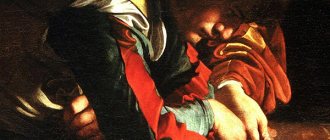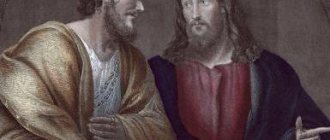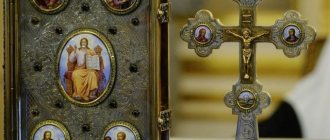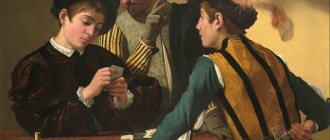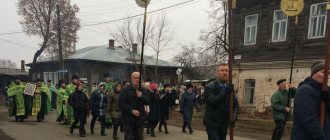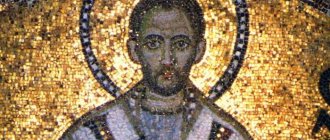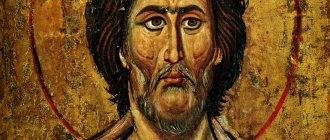“The Calling of Saint Matthew” (1600) is one of Caravaggio’s most unusual paintings. She created a sensation among the master's contemporaries.
Even now she seems extraordinary. Christ is not in the center. And not in the most visible place.
No, on the contrary. In the very corner of the picture. In the shadow. And even almost completely hidden by another figure! But we still see it right away. Thanks to his beautiful and noble gesture “You! Follow me!"
And who among those sitting is Matthew? Seems obvious. The one who points at himself “Who? I? Should I follow you? No. It's not him.
Although most art historians believe that this is Matthew. I still adhere to a different version. It is shared by a much smaller number of specialists. But still she is closer to me.
Apostle Matthew in art
The Apostle Matthew is depicted quite often in iconography and fine arts. This is explained by its essential significance in spreading the word of God.
For example, it is worth paying attention to the wonderful work “Apostle Matthew and the Angel” by the Italian painter of the Bolognese school, the magnificent master of the Baroque Reni Guido (November 4, 1575, Calvenzano - August 18, 1642, Bologna). He studied with Carracci and Ferrantini, was a graduate of the Bologna Academy of Arts, a guide and heir to its pictorial tradition and pedagogical system.
Guido Reni. Apostle Matthew and the angel, 1635-1640. Vatican Pinacoteca, Rome
Among the outstanding masterpieces of painting are three amazing paintings from the life of the apostle by the great Caravaggio (Italian Michelangelo Merisi da Caravaggio; September 29, 1571, Milan - July 18, 1610, Porto Ercole) - an Italian artist, reformer of European painting of the 17th century, founder of realism in painting , one of the greatest masters of the Baroque.
Caravaggio. The calling of the Apostle Matthew. Fragment. 1598-1601 Rome, Church of San Luigi dei Francesi
Caravaggio. The Calling of the Apostle Matthew
Mathieu Contrel (building contractor) left a will. According to him, it was necessary to decorate the chapel in the church with frescoes. He chose a specific topic and the required quantity. The contract was signed with the then famous painter Cesari d'Arpino. He was once a rival of Caravaggio. But since he was simply inundated with all kinds of orders, in 1599 he was only able to design the vault. There were serious concerns that the painting would not be completed in the required time.
The agreement with d'Arpino was broken. We decided to entrust this important matter to Caravaggio. Before that, he dealt only with private orders. This work became his first attempt at writing for a wide audience. The painter decided to completely abandon traditional frescoes. He preferred large canvases.
“The Calling of the Apostle Matthew” is the first painting. This work of the artist is rightfully the best creation, created on a rather rare subject.
Jesus himself saw Matthew and decided to call him to serve as an apostle. Caravaggio's interpretation is different. He depicts this plot as one of the scenes of ordinary life of that time. We see a dark room. People sit and count the proceeds. The young people turned around and looked attentively at those who entered. Matvey is dressed poorly. No one understood who he was except Levi.
The darkness is broken by a stream of light in the place where Jesus is with the Apostle Peter. This is a symbol of faith that suddenly burst into the world. Our gaze is strictly organized by the way it is directed. We involuntarily read the entire scene precisely, starting from the left. We can only see the hand and head of Jesus. He only came here for a minute, as his feet were turned towards the exit. Here the same gesture is repeated three times - an outstretched arm. Many researchers believe that this is no coincidence.
Michelangelo Caravaggio. Martyrdom of the Apostle Matthew. 1599-1602. San Luigi dei Francesi, Rome
Martyrdom of the Apostle Matthew by Michelangelo Merisi da Caravaggio. 1599-1600
This large dramatic painting was painted in 1599-1600. for the Contarelli Chapel in the Church of San Luigi dei Francesi in Rome. The saint's limply hanging hand and the bizarrely illuminated figures in the foreground lead the viewer's eye directly to the scene of violence. The lighting of the two central figures emphasizes the powerful contrast between the muscular body of the executioner and the old man helplessly spread out on the ground in the clothes of a priest. Matthew's body, with his arms spread to the side, seems to form a cross at the feet of the executioner. An invisible angel hands the executioner a palm branch, a symbol of martyrdom, which he tries to grab.
Michelangelo Caravaggio. Apostle Matthew and the Angel. 1599-1602. San Luigi dei Francesi, Rome
Caravaggio “The Calling of Matthew.” The most unusual painting by the master
Caravaggio. The Calling of Saint Matthew. 1599-1600 Church of San Luigi dei Francesi, Rome.
“The Calling of Saint Matthew” is one of Caravaggio’s most unusual paintings. She created a sensation among the master's contemporaries.
Even now she seems extraordinary. Christ is not in the center. And not in the most visible place.
No, on the contrary. In the very corner of the picture. In the shadow. And even almost completely hidden by another figure! But we still see it right away. Thanks to his beautiful and noble gesture “You! Follow me!"
And who among those sitting is Matthew? Seems obvious. The one who points at himself “Who? I? Should I follow you? No. It's not him.
Although most art historians believe that this is Matthew. I still adhere to a different version. It is shared by a much smaller number of specialists. But still she is closer to me.
Who is Matthew in the picture?
According to this less popular version, this is how I read the painting.
The taxpayer is sitting facing us. With beard. In a black beret with an expensive brooch. He is 35-38 years old. With one hand he places the coins in the middle of the table.
Next to him is a young man of 14-15 years old. Well dressed too. His son or student. And the old man. Apparently the accountant was taken with him.
The nobles themselves were unlikely to engage in such matters. Most likely, it was the manager and his assistants who came to pay taxes. For crossing the bridge. For using paved roads. You never know for what else.
Matthew is the city publican. In modern language - tax collector. With one hand he counts the coins. The other one holds the wallet tightly. He sits at the head of the table. On the chair. He's the boss here. The client can also sit on the bench.
Caravaggio. The Calling of Saint Matthew. Fragment. 1599-1600 Church of San Luigi dei Francesi, Rome. wga.hu
He's young. He is not yet thirty. But this is not surprising. After all, the profession was inherited from his father.
He took his bodyguard to the meeting with the taxpayer. This is a young man. Dexterously wielding a sword. Arriving at the tavern, he turned the bench across. And he brazenly sat down on her opposite the well-groomed young man. He is impudent and pugnacious. His hooked nose and small eyes match his sword. His image slightly frightens intractable debtors.
Suddenly Christ enters the tavern with the Apostle Peter. A ray of light “cuts” space. It was as if a ray of salvation had broken through into the dark world of sins and vices.
Caravaggio. The Calling of Saint Matthew. Fragment. 1599-1600 Church of San Luigi dei Francesi, Rome. wga.hu
The publican's bodyguard instinctively leaned forward. His hand reaches for the sword. Not surprising. In such a hot place you can meet anyone. Including thugs hungry for easy prey.
The young man, on the contrary, pulled back, leaning on his father or teacher. He's not used to everyday fights. Unlike its neighbor opposite.
Caravaggio. The Calling of Saint Matthew. Fragment. 1599-1600 Church of San Luigi dei Francesi, Rome. wga.hu
Matthew had not yet had time to raise his eyes. He is immersed in counting money. He still belongs to this world of sin and vice. But Christ is already calling him. We know that in a second he will look up. And he will follow the teacher.
Caravaggio. The Calling of Saint Matthew. Fragment. 1599-1600 Church of San Luigi dei Francesi, Rome. wga.hu
Another fact speaks in favor of the fact that it is the young man at the head of the table who is Saint Matthew.
For the same church, Caravaggio painted another painting, “St. Matthew and the Angel.”
Caravaggio. Saint Matthew and the Angel. 1600 (Copy). Original lost during World War II
Judging by this picture, Caravaggio depicted that same young man in old age. Same pose and look. The same big head and stocky figure. Look how different the man with the beard is from the old Matthew.
By the way, the painting “Saint Matthew and the Angel” is long-suffering. The customers did not accept it. The church servants were outraged by the sight of the saint. How is it possible? Some tramp with dirty heels. And he was hunched over a book! Where is the sublimity of the image? Where is the holiness?
This was not the only rejected work of the master. I wrote about this in detail in the article “Caravaggio. 5 incredible facts of life and creativity.”
To please the church, Caravaggio painted another “Saint Matthew”. She no longer resembles the young man. Apparently there was no time for that.
Caravaggio. Saint Matthew and the Angel. 1600 Church of San Luigi dei Francesi, Rome. Wikimedia.m.commons.org
Why did Caravaggio “hide” Christ?
Yes, the picture is unusual. Caravaggio was able to masterfully show the collision of the ordinary and the sinful. With a miracle and the light of hope for salvation.
Michelangelo Caravaggio. Apostle Matthew and the Angel. 1599-1602. San Luigi dei Francesi, Rome
The first version of the central painting of the cycle, dedicated to the Apostle Matthew, was rejected by the clergy as contrary to the canons.
The apostle, whose model was probably an elderly man from the people, sat in a chair with his bare, rough legs crossed. He peered carefully at the book lying on his lap, giving the impression that he hardly knew how to read and write. Bent over the apostle, in sharp contrast with him, was a beautiful angel, whose figure was clearly outlined by his clothes. The angel with great difficulty directed the movement of the hand of the writing apostle. The poses of the characters in the altar image were considered “inappropriate.” The painting was purchased by banker and collector Vincenzo Giustiniani, rescuing the artist from a difficult situation. This painting was later stored in Berlin and was destroyed in April 1945 during the storming of the city. Only a black and white reproduction of it has survived. In the second version of the painting, completed by 1602, the artist softened the original concept. The dimensions of the image were increased compared to the first version - by that time the customers had terminated the contract with the sculptor Jacob Kobert, who was supposed to sculpt the figure of the saint for the altar. Initially, it was assumed that Caravaggio’s painting would occupy a place slightly higher than the other two paintings in the chapel, above the sculpture; now they are located on the same level. In the second half of the 17th century, three paintings by Caravaggio, dedicated to the history of the apostle, were removed to the church crypt. Thanks to art critic Roberto Longhi, the paintings were rediscovered and shown in 1951 at Caravaggio’s first personal exhibition
Plot[ | ]
Two figures stand out brightly against a dull black background. Inspired Matthew listens to the heavenly messenger hovering above him in a whirlwind of white robes. Matthew's position is unstable - the simple stool on which he rests his knee is tilted over the void. At the same time, the apostle maintains naturalness and ease, recording the words of the angel. The gesture of the angel bending his fingers indicates that he is giving precise instructions.
The angel is a symbol of the Evangelist Matthew. According to the Golden Legend, Matthew has a symbol in the image of a man, because he pointed out the human nature of Jesus more clearly than other evangelists.
Pieter Aertsen (1508 - 1575) Four Evangelists
Also noteworthy is the painting by Pieter Aertsen (1508 - 1575) “The Four Evangelists”
Pieter Aertsen (1508 - 1575) Four Evangelists
The symbol of Matthew is an Angel standing behind him (at first the figure of a man was depicted, since the Gospel of Matthew begins with the genealogy of Christ as a man).
The evangelist Matthew, the author of the first Gospel, has been widely revered since ancient times. He had his own special iconography, where he was depicted creating the Gospel. This image can be found in monumental wall paintings, in icons, and in book miniatures. When copying New Testament texts, the Gospels were preceded by a sheet with an image of its author. And the first such miniature in the book was always the image of the Evangelist Matthew. It is his Gospel that begins the New Testament texts, since it is considered the oldest. In the miniatures, the apostle and evangelist Matthew are depicted sitting at a table with the necessary writing instruments.
Apostle Matthew. Iconography
Apostle Matthew. Iconography
Apostle Matthew. Iconography
Apostle Matthew. Iconography
Already from Byzantine times, images sought to diversify, representing the process of writing a book. For example, in one miniature Matthew unrolls a scroll, checking the text. This scheme became especially popular around 1300, and in Rus' they also tried to imitate it. In the era of Andrei Rublev (late 14th - early 15th centuries), on the contrary, uniformity in the depiction of the evangelists began to be valued more. This is exactly how the illustrations in the famous Khitrovo Gospel were made, which are usually attributed to Andrei Rublev himself. In this codex, as in a number of others, each miniature with an evangelist is supplemented by another sheet depicting his symbol. In Matthew these are images of an angel.
Apostle Matthew. Iconography
The tradition of depicting the symbols of the evangelists - an angel (Matthew), a lion (Mark), an ox (Luke) and an eagle (John) - is based on the Old Testament text of the vision of the prophet Ezekiel. God appeared to the prophet in a chariot carried by four cherubim, who were like a man, a lion, a bull and an eagle. The New Testament tradition associated these images with the four Gospels, and they came to symbolize their authors. Sometimes the symbols of the evangelists, without their personalized images, can be found on a wide variety of icons, such as, for example, “The Savior in Power,” where they are certainly depicted surrounded by Christ in the corners of the composition.
Apostle Matthew. Iconography
In the system of temple paintings, images of evangelists were placed in strictly established places. They were written on sails - four small triangular vaults supporting the central dome. At the base of such a sail is a dome pillar. The evangelists were presented as pillars of the Christian faith. Christ himself was depicted in the dome. This system was borrowed from Byzantium and was already present in the most ancient Russian churches.
Apostle Matthew. Iconography
Apostle Matthew. Iconography
Apostle Matthew. Iconography
Apostle Matthew. Iconography
One should distinguish between the Apostle and Evangelist Matthew and the Apostle Matthias (lat. Matthias), since they are often confused. Apostle Levi Matthew was one of the first to be called, and Matthias was the last. The Apostle Matthias (August 9) by lot took his place among the 12 apostles, instead of the fallen Judas Iscariot. Before that, he was one of the 70 disciples of Jesus.
Audio player
00:00
00:00
Use the up/down keys to increase or decrease the volume.
Author:
Tatiana
We publish in the telegram earlier than on the website.
Subscribe to the Pravlife Channel
Holy Publican from Capernaum
The holy apostle and evangelist Matthew (which means “gift of God”), son of Alpheus, lived in the Galilean city of Capernaum, which lay on the northwestern shore of the Sea of Galilee. Before his call to the apostleship, he was called Levi, as the evangelists Mark and Luke call him. After his calling, he was better known as Matthew. According to Blessed Jerome, his common name was Matthew, and his more honorable name, as if literary and religious, was Levi. The apostles, out of respect for him, call him by his best name, and he himself constantly calls himself Matthew, without being ashamed to talk about his former position, so despicable in the eyes of his compatriots. Matthew was a publican, that is, a tax collector for Rome. The people were predominantly selfish and cruel; publicans were considered by the Jews to be traitors to the people and apostates from God. Talking to a tax collector was considered a sin, and entering their houses was considered desecration. However, among the tax collectors there were good and God-fearing people. So was the future Apostle Matthew. Clement of Alexandria reports that Saint Matthew did not eat meat throughout his entire life, but ate only greens and fruits.
Matthew, like everyone like him, was despised by his compatriots. But the Lord fixed His Divine gaze on him, despised by everyone. The conversion and calling of the publican was probably prepared by the very circumstances of his life: Matthew more than once had the opportunity to hear the teaching of Jesus Christ in Capernaum, and witnessed His numerous miracles.
It is noteworthy that in the Gospel, which was written by Matthew in the year 41, eight years after the Ascension of Christ, the apostle sets out the story of his calling. Once, during His stay in Capernaum, the Lord left the city and, accompanied by the people, headed to the sea along the caravan road. Matthew, who was collecting duties from merchants passing here, was sitting near his tollhouse: “...Jesus saw a man sitting at the collection office named Matthew, and said to him: follow me. And he arose and followed Him” (Matthew 9:9). Turning to Matthew with this appeal, the Knower of the Heart knew that this publican would be His chosen vessel. Matthew, without hesitation, got up and left, leaving everything. He distributed his property to the poor and, together with the other apostles, followed Christ. And now he never left Him again. Soon Matthew was awarded by the Lord to be numbered among the twelve chosen apostles, being chosen to take the place of the fallen Judas. Together with other disciples of the Lord, Matthew accompanied Him on travels through Galilee and Judea, listened to His Divine teaching, saw countless miracles performed by Jesus Christ, went preaching to the lost sheep of the house of Israel, witnessed the suffering on the cross and the atoning death of the Savior and His ascension into heaven .
Holy Apostle Matthew and Angel
After the Ascension of the Lord and the descent of the Holy Spirit on the apostles, Saint Matthew remained in Palestine for eight years, together with the other apostles, preaching the Gospel in Jerusalem and its environs. When the time came for the apostle to leave Jerusalem for distant countries to convert peoples to the faith of Christ, the Jewish Christians of Jerusalem asked him to leave for them a written testimony about the life and teachings of Jesus Christ. This request was supported by the other apostles who were in Jerusalem at that time.
In terms of the time of its writing, this is the earliest of all four Gospels, therefore, among the books of the New Testament, the Gospel of Matthew comes first.
The place where the Gospel was written is called Palestine. It is believed that the Gospel was written by Saint Matthew at the request of the Jerusalem Christians at a time when, as a result of the strong persecution brought upon them, they were in danger of being scattered, and they wanted, wherever they were to be, to have with them a true story about earthly life and teachings of the God-man Jesus Christ. It is possible that the writing of the Gospel began at the time of the said persecution and was completed by the time the apostles left to preach in different countries.
Matthew wrote his Gospel in the Syrochaldean (or Aramaic) language, which was spoken by Palestinian Jews at that time, but in Hebrew letters, as Blessed Jerome notes. Later the Gospel was translated into Greek, and the Hebrew original was lost. There is a legend that the Evangelist Matthew himself translated the Gospel from the Hebrew. According to another version, the translation was made by the evangelist John the Theologian. One thing is certain: the Greek translation (which is recognized as canonical, since the Syrochaldean text was distorted by heretics) was made during the time of the apostles.
Evangelist Matthew, 13th century icon, Macedonia
In his Gospel, Matthew preaches primarily about the incarnation and humanity of Jesus Christ. In this context, it is noteworthy that already from the end of the 2nd century. in Christian theology, and from the 4th century. – and in Christian art the symbol of the Evangelist Matthew became the image of an angel. According to the interpretation of Irenaeus of Lyons, the human image of the angel was supposed to reflect the human genealogy of Christ with which the Gospel of Matthew begins.
Having left Jerusalem, the holy Apostle Matthew went around Macedonia, Syria, Persia, Parthia, and Media with the gospel. Finally, guided by the Holy Spirit, he came to Ethiopia. This country was inhabited by beast-like black people - cannibals. In a city called Myrmene, the apostle converted several idolaters to faith in Christ, founded a small church for the converts, and installed his companion Plato as bishop.
He himself retired to a nearby mountain and remained in fasting, earnestly praying to the Lord for the conversion of the Ethiopians. And then the Lord appeared to him in the form of a beautiful young man, with a rod in his hand. He commanded the apostle to come down from the mountain and plant the staff at the door of the church created in Mirmeni.
“This rod,” said the Lord, “by My power will grow into a tall tree, which will bear abundant fruit, surpassing in size and sweetness all other garden fruits; and from its root will flow a spring of pure water. Having washed in it, the cannibals will receive a beautiful face, and anyone who has tasted the fruit will forget their brutal morals and become a kind and meek person.”
Having accepted the rod from the hands of the Lord, the Apostle Matthew went down and went into the city to fulfill the command. On the way, he met the wife and son of the local prince Fulvian, possessed by an unclean spirit. “Who sent you with this rod to our destruction?” - they shouted in wild, threatening voices. Matthew, in the name of Christ, cast out unclean spirits and healed those possessed by demons. Both those healed bowed to the apostle and meekly followed him. This miracle converted many more pagans to the Lord.
Having learned about his arrival, at the entrance to the city the apostle was already met by Bishop Plato and the clergy. They all went to the temple and did as the Lord commanded: they stuck a rod into the ground, and it immediately grew into a large tree, and beautiful fruits appeared on it, large and sweet, and a babbling stream of crystal water flowed from the root. Everyone who saw this was amazed. Then the entire population of the city gathered at the temple, people drank water and ate fruits. The Apostle Matthew, standing on an elevated place, preached the Word of God to those gathered in their language. All those present there believed in Christ, and the Apostle baptized them in a miraculous spring. And all the baptized cannibals, according to the word of the Lord, became beautiful in complexion and lost the blackness of their skin.
Among those who believed and were baptized were the wife and son of ruler Fulvian. Having learned about what had happened, the prince at first rejoiced at the healing of his wife and son, but then, seeing that the people were leaving idols and going to the apostle to be baptized, he became angry with Matthew and planned to destroy him.
That same night the Savior appeared to the evangelist and commanded him to strengthen his spirit, promising not to leave him in the coming sorrows.
When morning came and the apostle, having risen from sleep, was praying in the temple with the believers, the prince sent four soldiers to arrest the saint. As soon as they arrived, darkness immediately enveloped them, so that they could hardly return back. The soldiers said in fear: “We heard his voice, but we could not only take him, but also could not see him.” Fulvian became even more angry. This time he sent even more armed soldiers to the temple, ordering Matthew to be brought at all costs. But these warriors also returned with nothing. The heavenly light shone on the apostle, and the guards, unable to look at him, threw down their weapons in horror and ran back, half-dead with fear.
Then, filled with rage, Fulvian, accompanied by a crowd of servants, himself went to take the apostle. But as soon as he approached him, he suddenly became blind and began to ask to be given a guide. Frightened, he began to beg the apostle to forgive his sins and restore his sight. Matthew made the sign of the cross in front of the prince, and Fulvian received his sight. But the miracle did not bring him to his senses. The ruler attributed this to sorcery and planned to burn Matthew as a sorcerer. Taking the apostle by the hand, Fulvian led him to his palace, as if wanting to honor him. But Matthew, foreseeing the evil plans, denounced the prince: “Flattering tormentor! Will you soon accomplish what you set out to do? Do what Satan has put in your heart - I am ready to endure everything for my God.”
By order of Fulvian, the soldiers stretched Matthew out on the ground, nailed his hands and feet with nails, put a lot of dry branches on top, doused it with resin and sulfur, and set it all on fire. A huge pillar of flame rose into the sky, and when it seemed to everyone that the apostle had burned, suddenly the fire cooled, the flame died out, and everyone saw the saint alive and unharmed and glorifying God. Seeing this, all the people were horrified by such a great miracle, and gave praise to the God of the apostle. Fulvian alone continued to remain blinded, furiously calling Matthew a sorcerer. The prince ordered to add brushwood to the fire and place twelve of his golden idols around it, hoping that with their help it would be possible to burn the apostle to ashes. Matthew, engulfed in flames, prayed to the Lord to show His power, to reveal the insignificance of the pagan gods and to shame those who trust in them. And then the flames fell on the idols with a terrible noise. They, like wax, melted in one minute, and many of those who stood nearby were scorched by fire.
From the melted idols another flame emerged, in the form of a serpent, and rushed towards Fulvian. Then the frightened ruler began to pray to the evangelist to deliver him from destruction, and through the prayer of the martyr, the demonic flame subsided. This was the moment of conversion for the black prince. He wanted to bring the saint out of the fire and give him all sorts of honors. But the apostle said his dying prayer and gave up his soul to the Lord. Then, by order of Fulvian, they brought a golden bed, placed on it the body of the holy martyr, undamaged by fire, covered it with precious clothes and carried it into the palace with honor.
Doubts, however, continued to sway Fulvian. He ordered an iron ark to be forged, the relics of the apostle placed in it, sealed tightly with tin and thrown into the sea. At the same time, the prince said that if the God of Matthew preserves the body of the apostle in water, as he preserved it in fire, then this One True God should be worshiped.
That same night, the Apostle Matthew appeared to Bishop Plato in a sleepy vision, saying: “Tomorrow go to the seashore, east of the princely palace, and there take my relics, carried to land.”
In the morning, the bishop, accompanied by many Christians, went to the sea and found an iron ark on the shore among the rocks. He was transferred with honor to the temple built by the apostle.
Ruler Fulvian and his retinue came to the seashore to see the miracle with their own eyes. And only then did he believe in Christ and loudly confessed Him as the One True God. Having fallen to the ark with the holy relics, the ruler asked the martyr for forgiveness and expressed a sincere desire to be baptized. Bishop Plato, seeing Fulvian's faith and zeal, baptized him with the name Matthew, which he gave him, fulfilling the command of God.
Having accepted the name of the apostle in baptism, the prince tried to imitate him in life. Soon he renounced princely power, devoted himself to fasting and prayer, and became a presbyter. After the death of Bishop Plato, the Apostle Matthew appeared to Fulvian and exhorted him to lead the Ethiopian Church. Having accepted the bishopric, Saint Matthew-Fulvian worked hard in preaching the Word of God, continuing the work of his heavenly patron.
